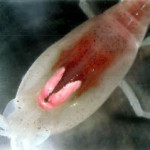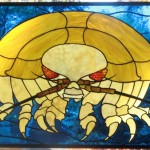We’re excited for another guest post from Kim Martini here at DSN (read previous posts here). Kim is a physical oceanographer working at the University of Alaska, Fairbanks. You can find her on Twitter at @rejectedbanana. Make sure to comment below and welcome her to DSN.
While the rest of the DSN scientists all seem to be jetting down to exotic tropical locales to do their research, I am headed in the other direction, NORTH! Our science team is headed to the Arctic for a two-week cruise to study the currents in the Chukchi Sea. And we are going to be throwing a lot of expensive sh*t into the ocean.
I’ve actually never been on an Arctic research cruise before. But I am definitely learning first hand how difficult it can be to work there. The cruise was supposed to leave 2 weeks ago, but was delayed due to lingering sea ice. It’s actually still out there, which will make navigating in vessel that is not ice-strengthened…interesting.
But how can that be you say, I heard we are currently at record low ice-levels in the Arctic?! And that is true, in the central Arctic Basin where it is really deep. But where we are going is incredibly shallow and the ice is literally “stuck.” Deep ice keels have grounded themselves. This is pretty common in the Chukchi. Near the shore, gouges caused by ice scraping over the bottom can be over 6 feet, deep enough that a diver can stand in it and not see out!

This will be a pretty exciting cruise, because we are using an armada of tools to study the currents. This includes shore-based radars to measure surface currents, an underwater moorings to measure underwater currents, satellite tracked drifters to follow surface currents, remotely controlled robots to follow the drifters and a CTD that we will be towing off the back of the ship. I’m especially excited about the last instrument, the towed CTD, not only because it flies underwater, but because that my baby. For the last month, I have been integrating the science payload onto the Acrobat and designing the software to read the data. Typically, we would field test the instrument before going out to sea. But due to time constraints we were not able to. So this is the first test of the Acrobat in an actual ocean. To quote Jesse Spano, “I’m so excited, I’m so scared!”
Anyway, I’ll be hopefully writing updates from the field. I say hopefully because we are still a little bit unclear about the internet situation while at sea. The boat has a very limited internet connection, but since we are coordinating with other scientists onshore to figure out where the exciting science is, we brought our own internet dish! I’ll also be posting updates on twitter @rejectedbanana, or you can check out the status of our data at the project website http://dm.sfos.uaf.edu/chukchi-beaufort/index.php .
And speaking of the difficulties of working in the Arctic, our flight to Deadhorse (yes this really is a place) is delayed due to fog. Quarter mile visibility, pretty typical this time of the year when moist North Slope air is cooled by the cold Arctic water. Good thing I packed extra sunglasses.





